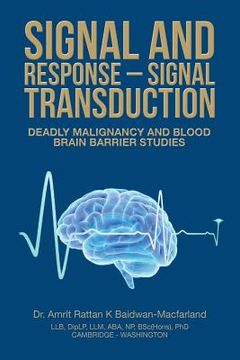Signal and Response - Signal Transduction: Deadly Malignancy and Blood Brain Barrier Studies (en Inglés)
Reseña del libro "Signal and Response - Signal Transduction: Deadly Malignancy and Blood Brain Barrier Studies (en Inglés)"
The ground-breaking scientific study of Amrit Rattan K Baidwan Macfarland (Amrit K Macfarland) asks why and how malignant cancers can be cured. This scientific status is visualised through novel ALL cells lines in vitro, in vivo, and in developing natural human foetal tissues. The resistance status of malignancy to treatment is determined by an inextricable connection between P-gp expression in malignant cell membranes exposed to drugs, blood-brain barrier developmental cells in human foetal cells, and ALL blood cells undergoing chemotherapy. A new type of concept is introduced here as a human P-gp resistance amalgamation (P-gp-MDR) is conceived. Multidrug resistance is created due to cellular and barrier programs through the expression of a membrane drug efflux pump with an ability to create downstream signal transduction systems and which regulates its function and activity. This includes cellular and barrier capacities to generate unforeseen, innovative signalling pathways on multiple levels that can jeopardise treatment pathways at key stages in a fatal way. At present, these systems were unrecognised as potential elements for targeting the killing of deadly malignancies, both in primary and secondary forms. The fact that the blood-brain barrier is such a robust, intelligent entity, interfaced between blood and brain, indicates that it is the essential guardian for the survival of the brain, and thus all human biological systems depend on it. Its expression is seen in developing foetal brain tissues. However, it is also a stumbling block to the eradication of malignant cells. These findings of inducible P-gp expression in cancer cells and those that will constitute the blood-brain barrier creates intense tension both in the malignant systems as well as in the natural systems surrounding them, raising questions as to how to intervene to preserve the normal and retain its autonomy whilst destroying destructive actions, like hijackings by the malignant cells; the source of these abnormal responses remains to be answered. This book dynamically argues that P-gp MDR 1 and MDR 3 and the expressive Pg-p brain-blood functions are necessary to address for new chemotherapeutic challenges. It is important to study in general and specific, intelligent malignant, and natural systems that create multidrug resistance to treatment. The creativity and actions of P-gp and its polymorphisms are distinct in natural cells and malignant cells, and P-gp and its polymorphisms are involved in the creation of acute multidrug resistance, and they act as deadly programmed protectors of the biological environments of malignant cells and the cells exposed to drug treatments. As such the structure and function of P-gp together constitutes fatal ends for the host and its systems - based on studies of human cell lines, in vitro systems, in vivo foetal systems, in vivo blood cell systems - and exhibits non-cooperation of cells to multidrug treatments. In short, ALL is a multifaceted disease and displays abnormal activation of signalling pathways, which in turn activate drug-resistance pumps. The ability to target elements that activate the drug transporter P-gp will then be key to success to overcome cancers in this cutting edge field of nano-micro-molecular genetics. AUTHORHOUSE - ACADEMIC PRESS

